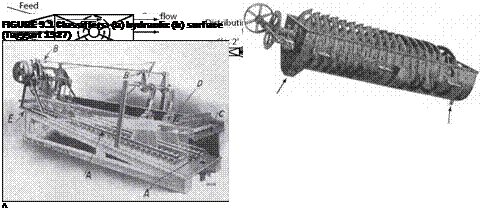Classifiers are devices for subjecting comminuted ore to the action of water either in such a way that a division of the ore particles is made into two or more products according to relative settling powers, or in such a way that all the ore material is settled together for dewatering purposes. …Classifiers all have a carrying current of water…which carries forward all grains remaining in suspension. (Richards and Locke 1940)
Classification equipment evolved from two sources, the simple expansion chamber and the Mumford and Moodie Separator. In the former, coarser particles drop out of an air stream as its velocity is decreased upon expanding to a larger space. Baffles, vanes or other directional and impact devices were later incorporated in the
147
expansion chamber to change the direction and provide collision surfaces to knock out coarser particles. …[In the Mumford and Moodie Separator] solids are fed into a rising air stream using a rotating distributor plate that imparts a centrifugal force. Coarser particles drop into the inner cone; the fines are swept upward by the action of an internal fan. (Klumpar, Currier, and Ring 1986)
The abrasion of rocks from wind and water and the classification and transport of fine solid particles have been some of the processes that have shaped the surface of the earth for eons. But it was not until the late 19th century that controlled classification was used as an industrial process and is now used extensively. It is an integral part of wet — and dry-grinding processes for two reasons:
1. Every continuous grinding process has internal classification. Particles of different sizes leave mills at rates that depend on their size and specific gravity, the smaller and lighter-weight particles being discharged at higher rates. The effect of in-mill classification can be seen in the coarse rocks and pebbles contained in autogenous mills.
2. External classification is used to ensure that the products of grinding meet the required specifications. It is the self-standing external classifiers that will be discussed in this chapter.
In 1900, grinding in wet ball mills was becoming accepted as a viable method for producing fine particles, but the mills were operated in open circuit. This meant that the products contained too many very fine particles if all the particles larger than the required top size were to be eliminated or too many coarse particles if overgrinding was to be avoided. The dilemma could be solved by discharging particles from the ball mill before too much overgrinding occurred, classifying it, and returning the coarse particles to the mill for further grinding. Classification of slurries was not new. The types of classifiers in use before 1900 were those in which
■ Rising currents of water sorted the particles into size fractions and removed the fine particles. Classification was precise but water use was large (Figure 9.1a).
■ The slurry flowed horizontally across settling boxes of increasing size, with the coarsest particles settling in the first box and finer products in later boxes (Figure 9.1b). This is the Rittinger classifier.
These classifiers produced sized fractions of ore for concentration by jigs or tables and were also used to remove -200-pm particles of quartz or their equivalent when they interfered with concentration. The fine product was very dilute.
John Dorr transformed wet classification. His place in the history of engineering was established when he invented a machine in which mineral slurries could be classified into fine and coarse streams with the fine stream containing up to 50%-60% solids and particles up to 200-300 pm, depending on the specific gravity of the mineral. He was also able to change the size at which the split was made, which was a significant advance as far as controlling the process was concerned. His classifier improved the precision of grinding and changed it into a continuous, high-capacity process for producing particles broken to the size at which they could be concentrated efficiently.
The Dorr classifier used the force of gravity to separate heavy and light particles. It may seem surprising that cyclone-type devices were little used for the classification of slurries until the 1960s, although centrifugal forces generated by the rotating flows in cyclone-type devices had been used since 1885 to separate dry heavy and light particles suspended in air. Their capital cost was much lower than the cost of mechanical classifiers, probably because for many years the available slurry pumps were not good enough
 |
FIGURE 9.2 (a) Dorr rake classifier: A = rakes, B = rake mechanism, C = fines discharge, D = feed box, E = coarse discharge (Richards and Locke 1940) (b) Akins classifier in which a screw conveyor moved coarse particles to the discharge (Truscott 1923)
to generate the required pressures. But there was no alternative to centrifugal classification for dry particles, so cyclone-type air classifiers had to be made to work.
